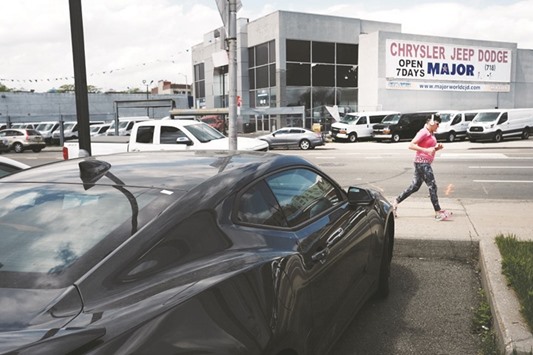US retail sales increased broadly in April while consumer prices rebounded, pointing to a pickup in economic growth and a gradual rise in inflation that could keep the Federal Reserve on track to raise interest rates next month.
The reports yesterday added to labour market data in suggesting the near stall in economic activity in the first quarter was an anomaly.
But a moderation in year-on-year inflation led financial markets to dial down expectations of at least two more rate increases this year.
“The economy picked it up a notch from the slow start earlier this year, but the inflation fires are not burning brightly and this will likely keep the Fed on just a gradual pace for interest rate hikes later this year,” said Chris Rupkey, chief economist at MUFG Union Bank in New York.
The Commerce Department said retail sales rose 0.4% last month after an upwardly revised 0.1% gain in March.
Sales rose 4.5% in April on a year-on-year basis.
Economists had forecast overall retail sales increasing 0.6% last month.
Excluding automobiles, gasoline, building materials and food services, retail sales gained 0.2% after advancing 0.7% in March.
These so-called core retail sales correspond most closely with the consumer spending component of gross domestic product.
The economy grew at a 0.7% annualised rate in the first quarter, held back by the weakest increase in consumer spending in more than seven years.
The Atlanta Fed estimates GDP will rise at a 3.6% pace in the second quarter.
In a separate report yesterday, the Labor Department said its Consumer Price Index rose 0.2% after dropping 0.3% in March.
The rise in prices suggested that March’s decline, which was the first in 13 months, was an aberration. In the 12 months through April, the CPI increased 2.2%. While that was a slowdown from March’s 2.4% increase, it still exceeded the 1.7% average annual increase over the past 10 years.
Financial markets are pricing in more than a 70% chance of a rate hike at the Fed’s June 13-14 policy meeting, according to CME Group’s FedWatch programme.
But the likelihood the US central bank will raise rates twice before the end of the year fell after yesterday’s data.
The Fed lifted its benchmark overnight interest rate by 25 basis points in March and has forecast two more hikes this year.
Prices of US Treasuries rose and the US dollar weakened against a basket of currencies after the release of yesterday’s data.
US stocks were trading mostly lower, pulled down by weak financial and industrial sectors.
Gasoline prices jumped 1.2% in April after falling 6.2% in March.
Food prices rose 0.2% as prices for fresh vegetables recorded their biggest increase since February 2011.
The so-called core CPI, which strips out food and energy costs, edged up 0.1% last month, reversing March’s 0.1% dip.
The monthly core CPI was restrained by declines in the prices of wireless phone services, medical care, motor vehicles and apparel. Rental costs increased 0.3% after a similar gain in March.
The core CPI increased 1.9% on a year-on-year basis, the smallest gain since October 2015, after rising 2.0% in March.
Still, April’s increase was above the 1.8% average annual increase over the past decade.
“To some extent, this new weakness in price inflation is due to competitive pressures rather than weak demand, so the Fed can afford to discount it,” said Paul Ashworth, chief US economist at Capital Economics in Toronto.
Consumer spending is being supported by a tightening labour market, marked by an unemployment rate at a 10-year low of 4.4%. A third report yesterday showed consumer sentiment rose in early May as the outlook for wages improved.
Motor vehicle sales increased 0.7% in April after three straight months of decreases. There were hefty gains in sales at building material and electronics and appliance stores.
But sales at clothing stores fell 0.5%. Department store retailers have been hurt by declining traffic in shopping malls and increased competition from online retailers, led by Amazon.com.
Retailer JC Penney Co said yesterday its net loss widened to $180mn, or 58 cents per share, in the first quarter.
On Thursday, Macy’s reported a 4.6% drop in first-quarter sales.
Sales at online retailers jumped 1.4% in April.

Cars are parked in a lot at an auto dealership in New York. The US Commerce Department said retail sales rose 0.4% last month after an upwardly revised 0.1% gain in March.
